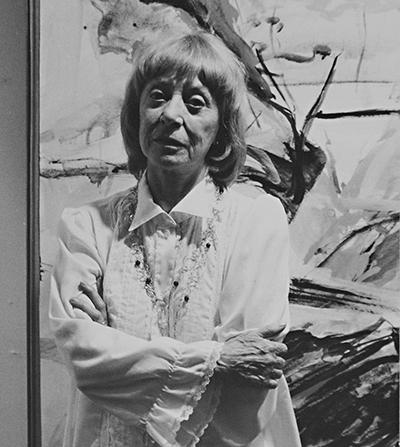The Many Faces Of Walter Weissman

For the past few months, Guild Hall has displayed an array of photographic portraits in the intimate space of its Wasserstein Gallery. The set of 15 predominantly black-and-white prints, the work of Walter Weissman, befit the room, and the room enhances them.
The rich architectural detail is a good backdrop for the artful yet spare images and prods the viewer to intuit that the photographs warrant sustained scrutiny. At first, the images look like accomplished candid snapshots, grabbed casually at a party. Gradually, however, it becomes obvious that something more is happening here.
The size of each image settles into the 18-by-12-inch range, large enough to bring out details about the personalities of the subjects, primarily artists. All were taken at public events, from the 1980s to about 2005.
There’s Roy Lichtenstein mixing it up in profile next to one of his linear archaic head sculptures, also in profile. Billy Joel, one of the many champions of South Fork baymen, stands solemnly with hands clasped next to Willem de Kooning’s “Clamdigger” sculpture. Chuck Close’s head is captured in a sea of Donald Sultan’s dots, a comment on both artists’ use of the compositional building block to very different ends.
In a 2011 profile, Mr. Weissman told The Star that even in informal settings, he works diligently to arrive at a definite shot. In the Chuck Close photo, the dots could have related to Hollywood lights or a make-up chair mirror, but to him they had a specific relationship to the artist’s painting process, in which he composes his subjects in a series of blips, rods, and specks.
Rather than the “decisive moment” of Henri Cartier-Bresson, Mr. Weissman looks for the elusive moment, one that may reveal something profound about his subject in a superficial setting. It is on the red carpet and at public appearances that the personalities of celebrities “hide in plain sight. The superficiality comes from how much can a photographer know about someone? How to get that introspective moment? The image must be revelatory.”
He sets up quite a challenge for himself, and, upon closer inspection, not all images succeed. While Mr. Joel appears solemn, he also looks vaguely annoyed. Larry Rivers, pictured during a panel discussion in 1991, looks too cropped, too close up, and inscrutable, his mouth forming a taut line. Edward Albee’s downcast eyes and slight frown conjure up a basset hound.
At a certain point, the viewer begins to wonder: Don’t a lot of people do this kind of thing for a living? Their images are published, too, but making prints out of them and hanging them on the wall as art does not seem to occur to most of them. The question is whether this photographer is different, and why?
Some images that help answer these reservations in the affirmative are those of Robert Rauschenberg, shown in a lighthearted moment in front of one of his “Combines” at the Knoedler Gallery in 1993, during its happier times. The gallery closed in scandal in 2011 after being found to be dealing in forged paintings. Its principals have been sued by several of their clients, including one case settled last week in New York City. The Knoedler’s appearance here reminds us why it was considered august in the first place.
In addition, Dan Flavin, seated, looks relaxed and full of bonhomie. Elaine de Kooning’s crossed arms and stern expression speak to her seriousness of purpose, while her frilly and billowy long white blouse give her an ethereal air. Eric Fischl looks open and engaged.
Over all, Mr. Weissman’s images are insightful and do have a thoughtful approach. They benefit from their contribution to the visual record of those artists, so many of whom are no longer here. That the bulk of the photos were taken in Guild Hall during its various openings and events makes it an appropriate home for them. In fact, the museum has acquired most of the images, a smart move to buttress its archives with documents of the artistic history of the area and its part in it.
The exhibition will be on view through Sunday.
